Water scarcity is one of the major problems facing major cities of the world and wastage during transmission has been identified as a major culprit; this is one of the motivations for this research, to deploy computing techniques in creating a barrier to wastage in order to not only provide more financial gains and energy saving, but also help the environment and water cycle which in turn ensures that we save water for our future. We presented our research in embedding a control system into an automatic water pump controller through the use of different technologies in its design, development, and implementation. The system used microcontroller to automate the process of water pumping in an over-head tank storage system and has the ability to detect the level of water in a tank, switch on/off the pump accordingly and display the status on an LCD screen. This research has successfully provided an improvement on existing water level controllers by its use of calibrated circuit to indicate the water level and use of DC instead of AC power thereby eliminating risk of electrocution.
Keywords |
| microcontroller, conductivity, water pump, assembly language, computer simulation, waste |
INTRODUCTION |
| Pumps are essential in the water supply field, wooden pumps existed in the 1700s and these were used to empty the
bilges of ships. They were made from bored logs with wooden pistons to create suction. Metal piston type pumps,
driven by steam, were developed in the early to mid-1800s but it was not until the advent of electrically driven pumps
that water system expansion became feasible on a large scale. Layne Bowler developed the first vertical turbine water
pumps in 1894 and Jacuzzi developed the first submersible pumps in the 1920s. These manufacturing developments
provided the hardware to allow the establishment of many New Hampshire public water systems in the very late 1800s
(Hicks et al., 1971). |
| Automatic water pump controller is a series of functions to control the Automatic Water Pump Controller Circuit in
a reservoir or water storage. The water level sensor is made with a metal plate mounted on the reservoir or water tank,
with a sensor in the short to create the top level and a detection sensor for detecting long again made for the lower level
and ground lines connected to the bottom of reservoirs or reservoir. |
| In everyday life, there must be some physical elements that need to be controlled in order for them to perform their
expected behaviours. A control system therefore can be defined as a device, or set of devices, that manages, commands,
directs or regulates the behaviour of other device(s) or system(s). Consequently, automatic controlling involves
designing a control system to function with minimal or no human interference. Intelligent systems are being used in a
wide range of fields including from medical sciences to financial sciences, education, law, and so on. Several of them
are embedded in the design of everyday devices. |
| This paper aimed at presenting our project in embedding a control system into an automatic water pump controller.
One of the motivations for this research was the need to bring a solution to the problem of water shortage in various
places eliminating the major culprit; waste of water during pumping and dispensing into overhead thanks. We believe
that creating a barrier to wastage will not only provide more financial gains and energy saving, but will also help the
environment and water cycle which in turn ensures that we save water for our future. |
II. RELATED WORKS |
| Khaled Reza el al., (2010) introduced the notion of water level monitoring and management within the context of
electrical conductivity of the water. The authors motivated by the technological affordances of mobile devices and the
believe that water level management approach would help in reducing the home power consumption and as well as
water overflow; investigated the microcontroller based water level sensing and controlling in a wired and wireless
environment. The research result was a flexible, economical and easy configurable system designed on a low cost
PIC16F84A microcontroller and finally, proposed a web and cellular based monitoring service protocol to determine
and senses water level globally. |
| A controller based automatic plant irrigation system was designed by Gunturi (2013). The main aim of the research
was is to provide automatic irrigation to the plants with a system that operates with less manpower. This in turn helps to
save funds and water. The researcher programmed the 8051 microcontroller as giving the interrupt signal to the
sprinkler, and this was used to control the entire system. Temperature sensor and humidity sensor were connected to
internal ports of the microcontroller via a comparator, and whenever there is a change in temperature and humidity of
the surroundings these sensors senses the change in temperature and humidity and gives an interrupt signal to the
micro-controller and thus the sprinkler is activated. |
| It was the position of a paper by Hodgson and Walter () that based on real world systems as the benchmark, using
optimization software in place of traditional design techniques results in significant cost savings for both first cost and
LCC. The researchers discussed the potentials of modern optimization technology to the pumping industry and
presented examples of cost-saving design experiences. |
| Rojiha (2013) analysed this existing oil-pumping system and discovered that they have a high power-consuming
process and needs more manual power. He then proposed a sensor network based intelligent control system for power
economy and efficient oil well health monitoring. Several basic sensors were used for oil well data sensing, and the
sensed data was given to the controller which processed the oil wells data and it was given to the oil pump control unit
which controls the process accordingly. If any abnormality is detected then the maintenance manager is notified
through an sms via the GSM. This system allowed oil wells tobe monitored and controlled from remote places.n easy
way to comply with the conference paper formatting requirements is to use this document as a template and simply
type your text into it. |
III. MATERIALS AND METHODS |
| In this work, the automatic water level monitor here presented consists of the following major units: sensors,
comparator circuit, microcontroller, display unit, and the pump and the core work of detecting the level of water is done
by the comparator. The diagram below describes the flow of operations in the system as well as their inter-operability
(Fig.1). |
| Taking advantage of the electrical conductivity property of water, we used the copper conductors as the water level
sensor. When water touches the copper sensor positioned at a particular level in the tank, voltage is transferred to the
copper which in turn is transferred to the comparator circuit for further processing. The LM324 comparator was used to
compare the inputs from the electrodes in the tank and with a pre-set resistance and output a HIGH or a LOW with
respect to the result from the comparison. This HIGH or LOW was fed into the microcontroller which in turn uses this
to control the water pump and display the appropriate status on an LCD screen. The programmable Atmel 89C52
microcontroller was programmed in Assembly Language and was used as the processor to control the functionalities of
the entire system. A Liquid Crystal Display (LCD) served as the output unit which showed the status of the system on a
screen. |
| Relays were used in building a switching unit that simply triggers the pump on or off, depending on the signal
received from the microcontroller. Four I/O ports were used and they have the connection to the microcontroller as
illustrated below (Fig.2). |
| Each of the four I/O pins is an 8-bit port and all upon reset were configured as output and had to be programmed in
order to work as input ports. |
| In order to successfully construct the hardware prototype, some other hardware devices were used. These include,
two plastic containers to represent water source and destinations respectively, power supply unit, constructed using a
240/12v-transformer, bridge rectifier, capacitor, and voltage regulator. The Alternating Current (AC) voltage supplied
by the Energy Distribution Company in Nigeria, the PHCN was stepped down and then converted to the DC level
required by the device. |
| The specific software tool deployed for the virtual design and the implementation of the device is the Proteus
simulation software. The software has two environments; the ISIS and the ARES environments. We used the ISIS
environment for the circuit design and instead of implementing the printing of the circuit board (PCB) in the ARES, we
used a Vero board for our hardware implementation. |
IV. RESULTS AND DISCUSSION |
| In this work, the microcontroller for the automatic water level monitor with feedback, having passed the necessary
tests with the other components interfaced to it, is hereby presented. With this implemented system, it is possible to
monitor the water level in an over-head tank, switch on the water pump when the tank is empty and switch off the same
pump when the tank is full without any need for human intervention. By so doing, the incidence of water wastage is
eliminated and abrupt cut-off of water supply is equally also eliminated. |
| As already highlighted in the previous sections, the microcontroller is the heart of this project work, as all the control
signals pass through and are processed by the microcontroller. The LCD was interfaced to the microcontroller in order
to display the status of the system as it operates. The LCD data port is connected to the port 2 of the microcontroller
(Fig.3) and through this port the microcontroller is able to send information or instruction codes to the LCD and equally
read the contents of the LCD’s internal registers. The microcontroller then processes the data received and uses it to
control the pump based on the written flow or control algorithm stored in its ROM. |
| The simulated software algorithm began with flow-chart (Fig.4) and finally the assembly language program, which
is converted to its machine code (HEX file) and written to the microcontroller’s internal ROM for the appropriate
controlling of the device. The schematic diagram of the device is shown in fig. 5 and the result from the Proteus
assembler simulation is as is seen in Fig.6. |
| The written program was loaded into a virtual microcontroller and then simulated. The output of the simulation
(Fig.6) was followed by the hardware implementation (Fig.7). |
| After construction, tests were carried out to ensure that the device is functioning according to the design
specifications. After a successful testing, the prototype design of the automatic water level monitor with feedback was
designed. All the sub-circuits were combined together with the microcontroller to obtain the model of the design. The
figure 5 above shows the circuit connections of all the sub-sections making up the automatic water level monitor with
feedback, with all of them interfaced with the 89C52 microcontroller. |
| The implementation of this work came with quite a number of challenges. A lot of the ICs were damaged in the
course of soldering them on the Vero board and we had to finally use sockets to protect the legs. Open circuit also
constituted a problem because some of the wires to be soldered did not make proper contact with the Vero board. |
V. SUMMARY AND CONCLUSION |
| Automatic water pump control system employs the use of different technologies in its design, development, and
implementation. The system used microcontroller to automate the process of water pumping in an over-head tank
storage system and has the ability to detect the level of water in a tank, switch on/off the pump accordingly and display
the status on an LCD screen. This research has successfully provided an improvement on existing water level
controllers by its use of calibrated circuit to indicate the water level and use of DC instead of AC power thereby
eliminating risk of electrocution. |
Figures at a glance |
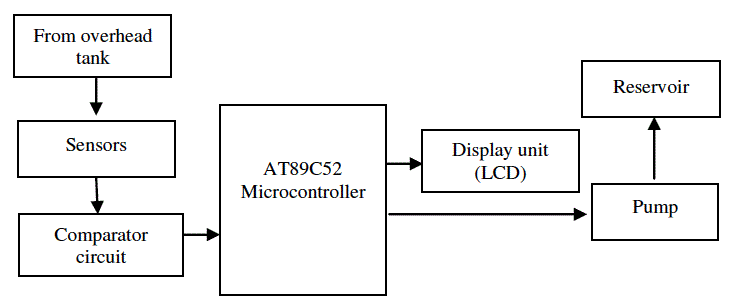 |
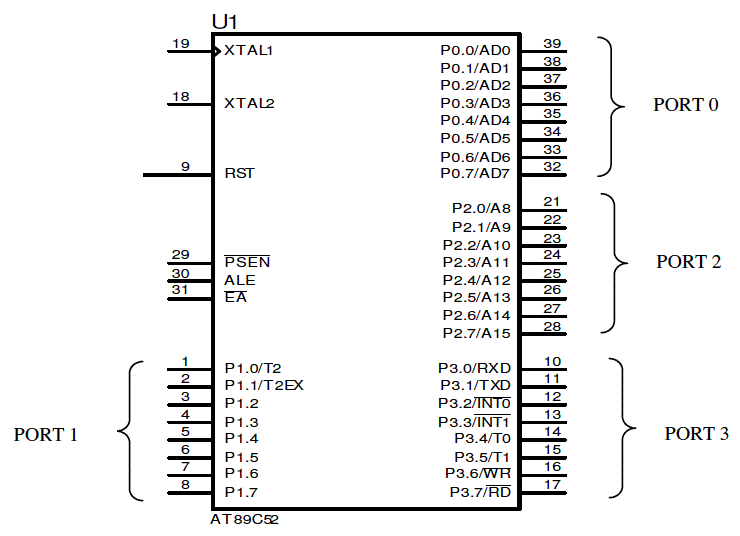 |
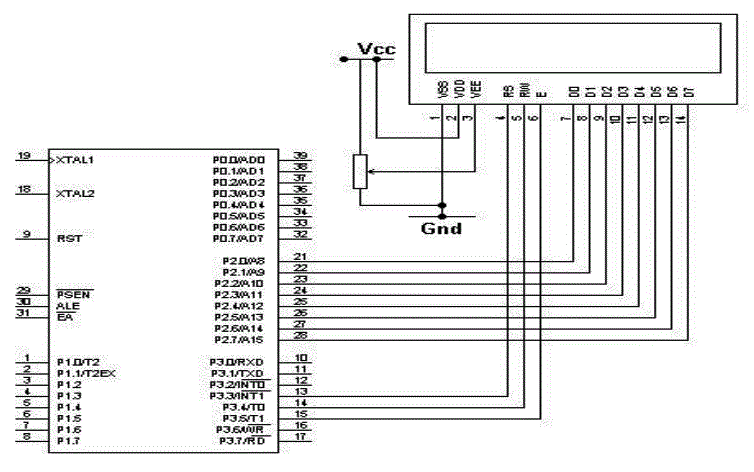 |
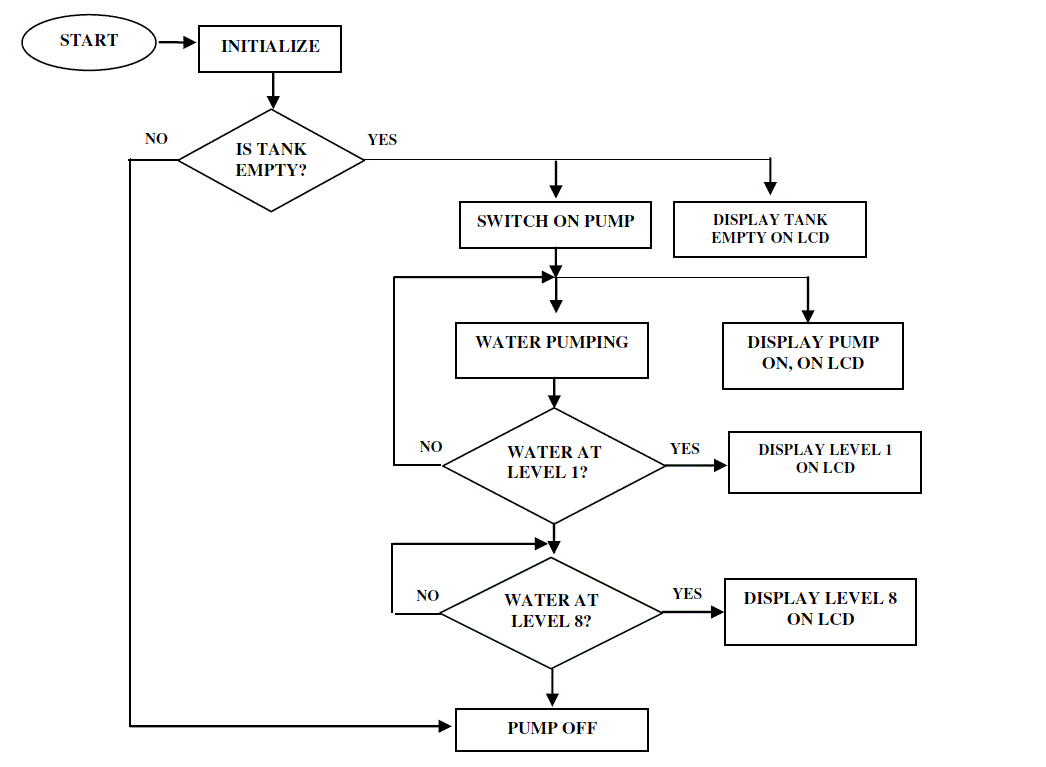 |
| Figure 1 |
Figure 2 |
Figure 3 |
Figure 4 |
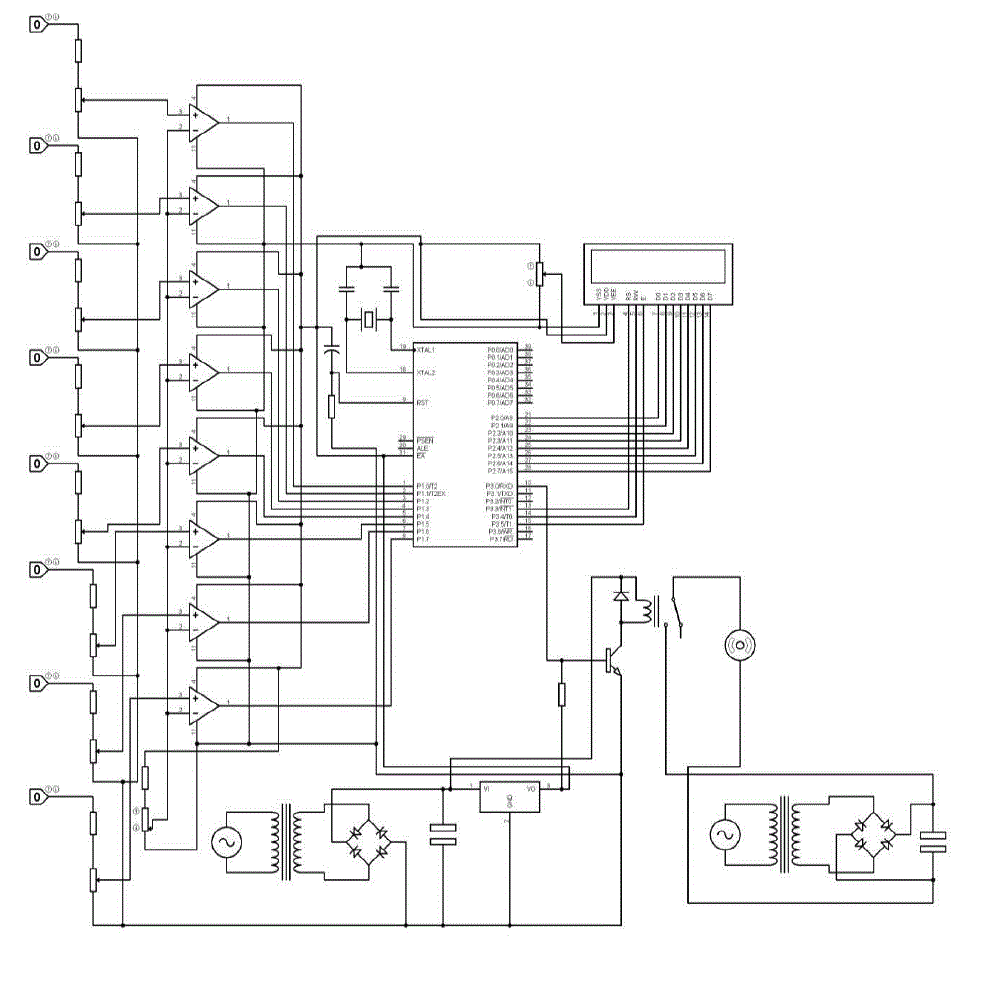 |
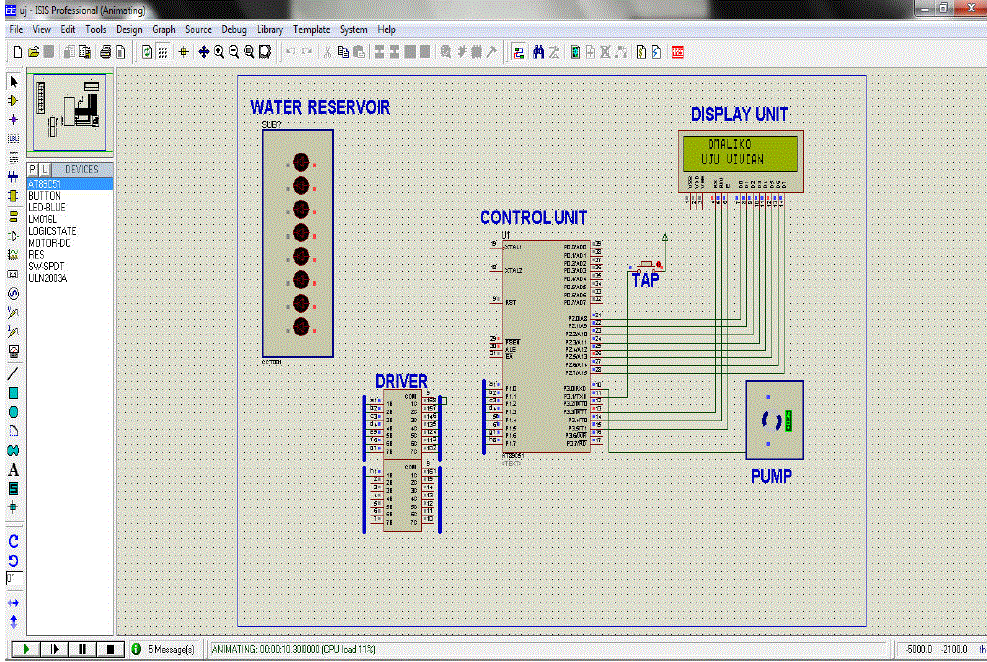 |
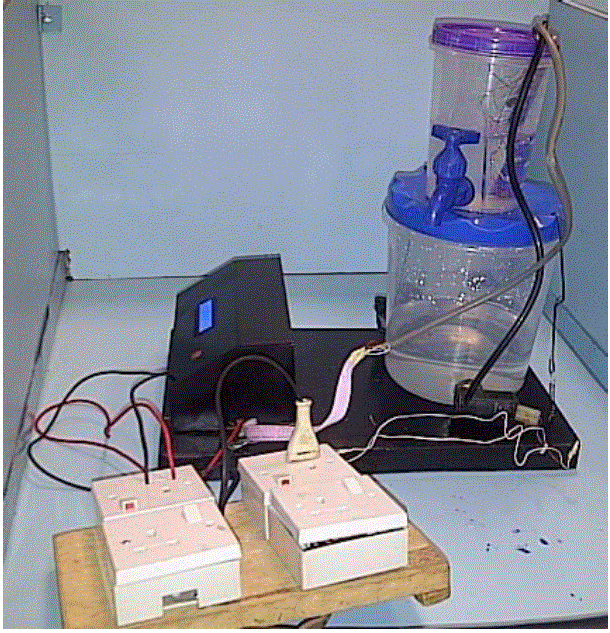 |
| Figure 5 |
Figure 6 |
Figure 7 |
|
| |
References |
- AT89C52 Datasheet; Atmel Corporation. Modified May, 2000. www.microchip.com.
- Hicks, F., Tyler, G.; & Edwards, T.W. (1971), ?Pump Application Engineering?. McGraw-Hill Book Company, New York.
- Khaled Reza, S.M., Shah Ahsanuzzaman Md. Tariq, S.M. Mohsin Reza (2010), ?Microcontroller Based Automated Water Level Sensing and Controlling: Design and Implementation Issue?. Proceedings of the World Congress on Engineering and Computer Science, pp 220-224.
- Venkata Naga Rohit Gunturi (2013), ?Micro Controller Based Automatic Plant Irrigation System?, International Journal of Advancements in Research & Technology, Vol. 2, Iss. 4, ISSN 2278-7763
- Judy Hodgson, Trey Walters(2002), ?Optimizing Pumping Systems To Minimize First Or Life-Cycle Cost?, Proceedings of the 19th international pump users symposium. Pp 1-8.
- Rojiha, C. (2013), ?Sensor Network Based Automatic Control System for Oil Pumping Unit Management?, International Journal of Scientific and Research Publications, Vol. 3, Iss. 3. Pp 1-4.
|